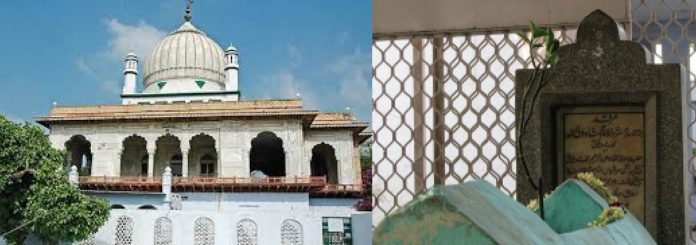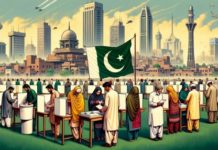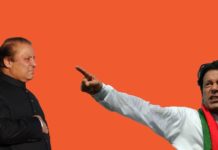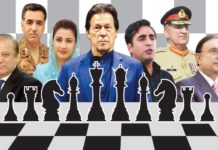Translator: Rabia Aslam
Source: Dr. Mubarak Ali, “Almiya Tareekh”, Chapter 9, Pages 82. 92, Fiction House Lahore, (2012).
After 1857, in order to increase the influence of the Ulema in the Muslim society of India, it was necessary to promote their positive role in history and to prove that the Ulema have always rendered excellent services to the society. This fabricated history was crafted by the religious scholars in the post-1857 era with devotion and emotion. However, the need for research or analysis of historical events were not taken into account. Rather, an attempt was made to show the sacrifices of the Ulema, their character, their devotion and commitment towards the religion. The best example in this regard is that of Molana Abul Kalam Azad (1888-1958) who was not a historian, but a good writer and essayist. The style he has adopted in mentioning the scholars in “Tazkira” is fiction, not history. But his historically delusional decisions impacted the basic fabric of the society in a very negative way. For example, regarding the personality of Ahmad Sirhindi (1564-1624), he says:
“At the twilight of Emperor Akbar and at the beginning of the reign of Jahangir, was India completely devoid of scholars and leaders? Look at the big names of that age! But no one could live up to the challenge of fighting the evil. It was only his eminence Mujaddid Alf-Sani Sheikh Ahmad Sirhindi (may Allah have mercy on him) was the sole personality who came up with a guide” (1).
About Shah Waliullah (1703-1762) he writes:
“The secrets of the Da’wah (to call towards religious path) of the Ummah, which had been buried in the ruins of Old Delhi and in the store-rooms of Kotla, have now become a commotion in the bazaars of Shahjahanabad and on the doorsteps of Jamia Mosque, thanks to the determination of Shah Walliullah. And even beyond the shores of India, his words spread like fire. The things that the elders could not bear to say even inside the closed cells, were now the talk of town. And the blood splattered words and stories were being recorded in the pages of history” (2).
This style of expression greatly influenced the educated Muslim class of India, and this misinterpretation of history became so ingrained in the minds that facts were greatly overlooked. Thus, a parallel to the political history of the rulers formed the religious history of the Ulema and by criticizing the political history of the rulers it was maintained that only the Ulema maintained the Islamic identity in Indian society. One of the difficulties that history writer clerics encountered in shaping the history of the Ulema was that during every time period holy men have cooperated and reconciled with the rulers. Therefore, these religio-historians came up with the solution to divide them into two categories – ‘Ulema-e-Soo’ (Scholars spreading evil) and ‘Ulema-e-Haq’ (Scholars inviting towards the right path).
Ulema-e-Soo opted for worldly gain, they were opportunistic and molded religion according to the needs of the rulers, while the scholars of truth stayed away from worldly benefits and spoke only of truth. But the problem was that each group called and labelled the other group as unguided and dubious, and tried to mold the historical events and facts according to their benefit. A group of religio-historians, who wanted to deepen the roots of orthodoxy in Muslim society, shaped the history of the subcontinent by focusing on Ahmad Sirhindi, Shah Waliullah and his family, and the personalities of Syed Ahmad Barelvi. They tried to design the historical events around these personalities. In doing so, the entire history was presented as a conflict between orthodox and religious innovations. On the one hand, there were the forces that sought to destroy the identity of Muslim society in India. On the other hand, there were Muslim scholars who were engaged in the struggle for the establishment of pure religion and Sharia.
From this point of view, Ahmad Sirhindi, Shah Waliullah and Syed Ahmad Barelvi are the only personalities in Indian history who not only defended orthodoxy with their writings, their actions and their struggles but also revived the spiritual movement.
Hence, these personalities were exaggerated through extravagant tales. For example, the followers of Ahmad Sirhindi believe that Islam in the Mughal period survived only because of him. And through his religious teaching and efforts, Emperor Jahangir and Shah Jahan adopted Islamic ways. The implementation of Shariah during Mughal period is also associated with his movement. As Sheikh Ikram has written, the statement of Abul Kalam Azad that Sheikh Ahmad Sirhindi single-handedly confronted the atheism of Akbar (1542-1605) created misleading ideas about Islamic history and these characters. And the clerics and religio-historians who came after Abul Kalam Azad tried to make Ahmad Sirhindi’s personality appear as a very pious figure in the light of this phrase. In this way Akbar and Ahmad Sirhindi were painted as two main conflicting personalities in the eyes of the masses.
Akbar was a supporter of Indian nationalism, a follower of peace, a supporter of reason and a backer of co-existence, while Ahmad Sirhindi a proponent of Islamic identity, orthodox and pure Islam and Sharia. In this conflict, Ahmad Sirhindi is declared the winner due to which Islamic laws were enforced in the court of Jahangir (1569-1627) and Shah Jahan (1592-1666), Dara Shukoh was defeated and Mohiuddin Aurangzeb (1618-1707) rose to power.
In an attempt to elevate and glorify the personality of Ahmed Sirhindi, the reign of Akbar is portrayed as disgusting and un-Islamic. They seek to prove that he was a promoter of non-Sharia and non-Islamic traditions. And during his reign the dominance of Hindus had increased. They began to perform their religious duties in public, which was a disgrace to an Islamic government. And Islam was almost extinct in India. Maulana Manazer Ahsan Gilani, a religious scholar, has written an article on this contest between Akbar and Ahmad Sirhindi. In it, he details the un-Islamic traditions that flourished during Akbar’s reign as:
“interest, gambling and alcohol were allowed, keeping beards was prohibited, ridiculous amendments to marriage laws were made, ‘ghusl’ (ritual washing of the whole body, as prescribed by Islamic law) was abolished, nudity, rise in adultery, the sanctity of pigs and dogs, the sacredness of cows and buffaloes, and the passion for Hindi books, were promoted”.
He has based all his allegations on the book “muntakhab ur-tawarikh” by Mullah Abdul Qadir Badauni, a historian of Akbar’s Court. The way in which the events are distorted and the meanings of his choice are deduced can be gauged from the original statements of Badauni himself. For example, regarding the reforms made by Akbar about alcohol consuption, Badauni writes:
“Alcohol is permissible for medical use only, as prescribed by the physician, provided there is no temptation to drink it for recreational purposes. However, if the news of excessive intoxication and the noise of people gathering due to it reached the king, he would strike hard” (3).
The rules regarding marriage that Maulana is calling ridiculous are as follows:
“Marriage for boys before the age of 16 and for girls before the age of 14 will not be legal. Because children are born weak” (4).
Also, Akbar had insisted that no one should keep more than one wife. As far as the accusation of promoting adultery is concerned, Badauni has the following to say:
“A settlement (red light area) was formed outside the city and it was named ‘Shaitanpura’ (city of the devil). Official bodyguards, caretakers and custodians were appointed there so that whoever wanted to indulge in adultery, should submit his name in the official records”. (5)
Similarly, Akbar’s Deen-e-Ilahi (Divine Religion) is presented as a new religion and the social and societal reforms of his era are declared un-Islamic and the personality of Ahmad Sirhindi is exalted to the status of his rival. Not only this, but the role of the scholars of Akbar’s time is also undermined in order to prove that it was only Ahmed Sirhindi who performed the deeds of service to the religion. Although contemporary histories make it clear that Ahmad Sirhindi was an anonymous figure in Akbar’s era. In the time of Jahangir, his influence was limited to a restricted circle of his disciples. And the letters he wrote to Jahangir’s ministers do not appear to have been taken seriously and it is difficult to tell the extent to which these ministers were devoted to him. Because the tone of these letters, according to Professor Mujib, is sometimes flattering. His followers later engineered his character on the assumption that his letters influenced the Emperor and changed the atmosphere of the court.
Here, it seems appropriate to remind that no single individual in history has been effective alone. And no one is able to change the situation or the historical process single-handedly. Unless the political, social and economic factors of the society join together, no movement can have a significant impact on the society.
In addition, there are different class interests that play in the background of every movement and make the movement effective. In Germany, Martin Luther succeeded against the Pope and the Catholic Church because he had a majority in society who were disgusted with the plunder of the Catholic Church. The German rulers supported it because their power and authority was limited because of the Catholic Church. So they sided with Martin Luther in pursuing their own interests. During the reign of Akbar however, there was no mention of such unrest among the people, but the social, political and economic reforms he had carried out throughout his reign had contributed to the stabilization of the society. There must have been only a limited class of scholars and elites who were opposed to Akbar’s policy of tolerance and reconciliation. But the influence of this segment was so limited that they could not make any case or could hardly bring about a change. Therefore, in the Akbar’s era, Ahmad Sirhindi’s personality was unknown whose influence was limited to his own disciples. Presenting him as a popular scholar and activist is the work of modern clerics and religio-historians.
Another figure who is being given great importance in modern times is that of Shah Waliullah (1703-1762). The question arises as to whether Shah Waliullah succeeded in influencing peoples mentally in his time. Mahmoud Ahmad Barkati has tried the answer it in this way:
“In his own time, his influence was very limited because at that time there was no printing press in India, so the number of books was limited and the manuscripts reached very few people. Additionally, there were very few people who could read. Shah Waliullah’s successors rarely reflected his writings and ideas. Even none of his books were included in the syllabus of Deoband” (6).
The personality of Shah Waliullah has been given prominence in modern times and most of the credit goes to Maulana Obaidullah Sindhi, who was greatly affected by the changing circumstances after leaving India. In particular, the Russian Revolution of 1917 had a profound effect on his mind and he became a staunch supporter of the communist system. But the problem with him was that he was not ready to adopt this system in an un-Islamic form. Therefore, he started looking for a Muslim thinker who could make replace Marx in his ideology of Islamic socialism. For this purpose, he got some economic ideas from Shah Waliullah which he presented in modern language and made it appear contemporary and revolutionary.
Interpreting the thoughts and ideas of Shah Waliullah, he highlighted the aspects that were in line with his ideas. He has expressed this in “Shah Waliullah ki siyasi tehreek” and other essays by him. Inspired by Obaidullah Sindhi, Maulana Muhammad Mian in second volume of his book “Ulama-e-Hind ka shandar maazi”, in which he wrote the history of the Ulema (of his sect) with great passion, he called Shah Waliullah a revolutionary. He even lauded the imaginary movement initiated by Shah Walliullah. Here are some excerpts from his book:
“Shah Sahib was a supporter of the military revolution, but a military revolution based on the principles of jihad. Such a revolution cannot take place through professional soldiers but through volunteers who have been specially trained. Shah Waliullah was the first to perform this service. He established training centers and presented corrective ideas” (7).
“Therefore, both morality and religion demanded that for the revolution the first to be trained was the one whose supreme authority was trusted by the whole country and whose shoulders were burdened with the work of development and welfare of all the faithful” (8).
He then goes on to describe the ‘centers’ of Shah Waliullah’s movement, including Delhi, Rai Bareli, Madrasa Najibabad, Thatta and Lucknow, where, according to him, for the revolution, Shah Waliullah trained Muslim rulers.
The thoughts and ideas of Shah Waliullah did not produce any practical results in his time and failed miserably, now these ideas are being presented as the solution to the problems of modern times and to bridge them to the light of modern knowledge, his ideas are being presented in modern terminology. The question arises as to why this importance is being given to Shah Waliullah when he could not affect the society of his time and the social decline that took place during the fall of the Mughals. How can this outdated wisdom be useful today when conditions and social dynamics have changed drastically? The answer to this question can be understood in this way that since the fall of the Mughals, Muslim society in Britsh India was so backward and ignorant that it could not produce an intellectual brain who understood modern day problems. Looking for a solution, Muslim society could not produce any creative thinker, politician or a philosopher.
Hence, because of the inferiority complex the Muslim society of today tries to lift their low self-esteem by labelling every other religious leader as “Allama” or “Great Thinker”. This deficiency re-created Shah Waliullah. His writings were researched and presented in a modern form as the savior of Muslim society. Not only that, but his entire family was given the status of a movement so that the chain that started with Ahmed Sirhindi could not be broken and its continuity could be maintained. This movement was formed on assumptions. The manner in which this fictitious movement has been presented by the famous historian of our time, Ishtiaq Hussain Qureshi, gives the impression that it was a very organized and active movement.
“If the movement was to become popular, its organization and planning had to be very careful and it had to be led by competent and trustworthy leaders. There was a need to pave the ground with great care, to prepare the people for support, to set up centers at various places for the provision of money and volunteers, and to set possible attainable goals, and after the completion of this work the movement had to give out the verdict. However, Shah Abdul Aziz (son of Shah Waliullah) and his companions gradually overcame these difficulties with great patience. His opportunism and his cautious approach are commendable, as he did not allow the British to intervene” (9).
Thus, the “Tehreek-e-Mujahideen” (Jihad Movement) of Syed Ahmad Shaheed (1786-1831) was declared a practical outcome of the movement of Shah Waliullah and his family as they tried to put into practice the ideas of Ahmad Sirhindi and Shah Waliullah. In the books written by Maulana Abul Hassan Nadwi and Maulana Ghulam Rasool Mehr on Syed Ahmad Shaheed, they have reviewed this whole movement with passion and Ishtiaq Hussain Qureshi has also described it as a part of Shah Waliullah’s movement.
“Shah Abdul Aziz was instrumental in preparing Syed Ahmed to lead this new movement. To support the hypothesis that Shah Abdul Aziz had given much thought to the issue of Jihad and had devised a plan for it, there is strong evidence. Like many others, it was natural for their minds to be drawn to Afghanistan and the Pathan tribes” (10).
It is the work of modern clerics and a few religio-historians to present Shah Waliullah’s work as a movement. And it’s all a matter of moving away from historical facts. This was necessary because when the independence movement against the British began, the scholars also started participating in it. In order to improve one’s status in Muslim society, it was necessary to glorify the role of one’s class in the past. To prove that the scholars have led the Muslim community at every opportunity, at every stage and therefore, their leadership should be trusted and relied on even in the modern age, efforts were made to prove through history the dedication and devotion of the religious leaders, their sacrifices, their bravery and truthfulness. It was also necessary for the Ulema to be active and dynamic because they did not want the power of the Muslim society to fall into the hands of modern educated and secular minded people.
It has been unfortunate for the Urdu language that instead of adopting a scientific approach in historiography, it has been made a means of expressing emotions. The task of writing history in Urdu was done by this group which belonged to the Ulema. So they made it a means of propagating their religious ideas. History was told in such a way that historical events and historical figures lost their form and were transformed into supernatural beings or sacred cows. The scholars who have worked to make history religious include Maulana Abu Kalam Azad, Maulana Manzar Ahsan Gilani, Maulana Muhammad Mian, Maulana Abul Ala Maududi and Maulana Manzoor Nomani. These gentlemen were not historians and their purpose was not to discover or analyze historical facts. Rather, they wanted to make history a means of propagating their religious beliefs. But their writings created great historical misunderstandings among the Muslims of the subcontinent.
The mental development of any society depends on the literature that is available to it. Since there were no other writings besides these, a certain kind of view of history has been born in our society and it became so ingrained in the minds that it has become a difficult task to remove or correct it. For example, when writing the history of the subcontinent, our historians look at the situation and events only from their own point of view. And inevitably, this is the only point of view. Instead of acknowledging the mistakes and evils, they seek to justify them. They completely ignore the fact that in the medieval society of Indian Sub-continent, where there were people of other religions and sects, their point of view should also be respected and their sentiments must be reflected in the course of history too.
When our historians defend the religious prejudice of Muslim rulers or scholars, arguments are made unilaterally to justify them. Ahmed Sirhindi’s attitude towards Hindus was very bigoted. Commenting on this, Sheikh Ikram writes in his book “Rood-e-Kausar” that the justification for his hate expressed in his letters towards non-Muslims and urging Muslims to humiliate them was as follows: ۔
“At that time, the movement for the revival of religion was in full swing among the Hindus and the demonstrations taking place around the country had hurt the hearts of the proud Muslims. Ahmed Sirhindi was very worried about these incidents and a fire of vengeance and wrath was kindled in his heart” (11).
The question here arises: don’t other religious communities have the right to revive their religion? Defend it? Is this right reserved only for Muslims? This kind of argument is often given in history that Mahmud Ghaznavi or Aurangzeb demolished Hindu temples because they were the center of Hindu conspiracy. Can we apply this to our religious centers as well? The result of this mentality is that we still look at every issue only one-sidedly and completely ignore the arguments and ideas of others. While living in India, the Muslim condemns “Ram Raj”, in Pakistan they strongly support the revival of Islam. Not only does this show the immaturity of our consciousness, but it has also limited our minds and made prejudice and narrow-mindedness ingrained in our personality.
It is on this basis that the history of independence movement has been molded in Pakistan. It begins with Sheikh Ahmad Sirhindi and Shah Waliullah, whose ideologies justify the two-nation theory and who are credited with sharply maintaining the differences between Hindus and Muslims. Orthodoxy is praised and (instead of Aurangzeb) Akbar is blamed for the decline of the Muslims as to why he included the Hindus in the government. Because only a Muslim has the right to rule in a Muslim government, not other religions. In the textbooks written based on these ideas, historical events are distorted in such a way that the students and the readers remain ignorant. Due to the lack of accurate knowledge of events, the masses could not become acquainted with the ideas of these personalities, nor could they understand the devastating effects of their teachings. Hence, they could not learn anything because of this narrow-mindedness. Therefore, today we find ourselves helpless to tackle the issues of the modern age. Perhaps this too is the purpose of historiography in Pakistan.
Read also: Role of Muslim Clergy in Medieval Society of the IndiaSubcontinent
Read also: Syed Ahmed Barelvi and His Jihad Movement
References:
(1) Abul Kalam Azad, “Tazkira”, p. 238, Lahore (1981).
(2) Abul Kalam Azad, “Tazkira”, p. 245, Lahore (1981).
(3) Abdul Qadir Badauni, “Muntakhab-ut-Tawarikh” (Urdu tr.) p. 497, Lahore (1962).
(4) Abdul Qadir Badauni, “Muntakhab-ut-Tawarikh” (Urdu tr.) p. 499, Lahore (1962).
(5) Ibid., p. 497
(6) Mahmood Ahmad Barakati, “Shah Waliullah Aur Un Ka Khandan”, Lahore (1976).
(7) Muhammad Mian, “Ulama-e-Hind ka Shandar Maazi”, vol. 2, pp. 7 – 8, Delhi (1957).
(8) Muhammad Mian, “Ulama-e-Hind ka Shandar Maazi”, vol. 2, p. 40, Delhi (1957).
(9) Ishtiaq Hussain Qureshi, “Bar-e-Azeem Pak-o-Hind ki Millat-e-Islamia”, pp. 251 – 252, Karachi (1967).
(10) Ishtiaq Hussain Qureshi, “Bar-e-Azeem Pak-o-Hind ki Millat-e-Islamia”, pp. 251 – 252, Karachi (1967).
(11) Ibid., pp. 253 – 254.
(12) Sheikh Muhammad Ikram, “Rood-e-Kausar”, p. 319, Lahore (1967).








